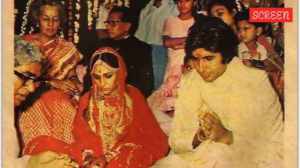The shock of the real
What makes outtakes and raw footage such fun to watch?
What makes outtakes and raw footage such fun to watch?
As media events go,Operation Geronimo was a carefully curated affair. It took place in the dead of the night,away from the worlds eyes. We only saw a few culled images,released over several days. Among them was the home video of a grey-haired Osama bin Laden wrapped in an old blanket,watching videos of himself on an old CRT screen. Another video shows the al-Qaeda leader with his beard freshly dyed,rehearsing a propaganda video and botching his lines. There was something poignant about it as The New York Times put it,it was like an ageing actor imagining a comeback.
For the US,releasing that video was a clear attempt to knock bin Laden down,reveal the creaky effort that went into his charisma. These sad images couldnt be further from the meticulously composed videos we have seen so far from the bin Laden studio,with rugged backdrops and controlled performances by OBL himself.
Earlier in 2006,American Special Operations forces had released another set of videos of the feared jihadist,Abu Musab al-Zarqawi,who specialised in videotaped beheadings. In the outtakes,al-Zarqawi was shown fumbling with a jammed machine gun,a flunky fixing it,wearing cheery US-made sneakers under his black guerrilla outfit. These releases are designed to puncture their aura,reveal them as tired,fallible humans.
What explains the appeal of these behind-the-scenes moments? You see the shakiness of authority because you have seen it half-made,caught in the act of composing itself.
Any choreographed act makes you wonder about the backstage where it all came together. Even behind the scenes of a fashion show,you want to see the process of transformation,the gawky girls made over into these flamboyant visions. They show you the trial and error,what it takes to go from the Before to the After.
And the more poised and finished something looks,the greater the pull of the raw footage. Which is why news anchors flubbing their lines or pulling faces used to be such fun to watch,until it became a tiresome convention.
Or think of literature the many iterations it goes through to become what it is. Its one thing to read a formally published work,and another to read the raw journal,crossed-over notes and unremarkable private thoughts that went into the writing. For instance,the anthropologist Bronislaw Malinowski wrote a disturbingly honest notebook along with his fieldwork,A Diary in the Strict Sense of the Term,which was later hailed as a remarkable backstage account of anthropology. It was full of his boredom and frustration with New Guinea,his lust for the indigenous women,and all sorts of personal observations that had no place in his academic work.
Outtakes,rehearsals and rough drafts are especially interesting in areas where the artifice isnt acknowledged,like with political performances. For instance,Richard Nixon prepared two versions for the moon landing of 1969,the famous one that was actually delivered,and another one in the event that it went terribly wrong. He would have read that one out with seeming spontaneity and feeling,and his listeners would have been moved,not realising that even the most emotional moments in public life are coldly prepared. Who knows,its very likely Obama had a speech ready in case Operation Geronimo crashed.
Authority is crucially a matter of performance we expect a certain bearing from our leaders,the props and sets of power are important. So the more elevated someone is,the more likely they are to favour ceremony over candour. And that also heightens the joy of an unscripted moment. Like when George W. Bushs Yo,Blair expletive-laced straight talk was overheard on an unguarded open microphone at a G-8 summit,or the more recent Kanye West-jackass controversy. Those flashes of honesty only underscored how dried-out and dull the normal political discourse is.
Back home,the reason anyone listened to the Radia tapes was for the fun of hearing real human voices,bitchery,gossip and anecdote rather than the monotone of the press release and party statement.
Of course,public figures can just as easily exploit the appeal of unedited moments. Angelina Jolie expertly manipulated the media at every step,refusing a formal interview after her 2003 divorce,but informing Us magazine where and when she would be publicly playing with her toddler Maddox. The resulting candid shots humanised and endeared her to people,cast her as a vulnerable young mother struggling for privacy.
Of course,now its a lot harder to stage-manage everything,with 360 degrees media coverage. Even though PR is more sophisticated than ever,it is no match for personal media,for the ease with which fakery can be caught and busted on the Web. For all the attempts to spin public life as a series of flattering photo-ops,reality has an inconvenient way of pushing its way in.
amulya.gopalakrishnanexpressindia.com
- 01
- 02
- 03
- 04
- 05































